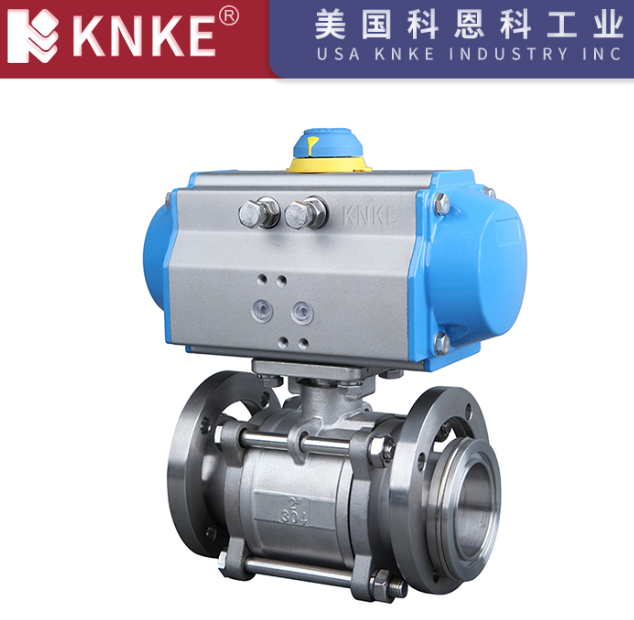Common Pneumatic Ball Valve Failures and Maintenance
Pneumatic ball valves are commonly used control valves in various industrial automation systems due to their simple structure, stable performance, and ease of operation. They are widely used in industries such as petroleum, chemical, electric power, and steel. However, over time, pneumatic ball valves may experience certain failures. Regular maintenance is essential to ensure their proper functioning and extend their service life. This article will cover common pneumatic ball valve failures and the necessary maintenance measures.

Common Pneumatic Ball Valve Failures
- Valve Sticking or Failure to Open/Close Properly
- Cause: Long periods without maintenance can result in dirt and impurities accumulating inside the valve, causing it to become stuck or fail to open and close smoothly. Additionally, inadequate lubrication can increase friction, preventing smooth operation.
- Solution: Regularly inspect and lubricate the valve body and stem. Ensure that no impurities accumulate, and add appropriate lubricants to the valve components to maintain flexibility and proper sealing.
- Gas Leakage
- Cause: Worn or damaged sealing components may lead to gas leakage.
- Solution: Inspect sealing components such as the seat seals and stem seals. Replace any damaged, aged, or excessively worn seals. Use high-quality sealing materials and choose seals based on the operating conditions of the valve.
- Unstable Valve Action
- Cause: An unstable gas supply or moisture in the air may cause the pneumatic actuator to malfunction. Additionally, damaged cylinder seals or actuator failures may affect the valve’s operation.
- Solution: Ensure a stable and dry gas supply. Regularly check and clear any moisture from the gas supply system. Install dryers if necessary. Also, check the pneumatic actuator for issues and replace any damaged components.
- Control System Failure
- Cause: Loose electrical connections, lost control signals, or aging control cables may cause issues with the valve’s control system.
- Solution: Regularly inspect control cables and connections to ensure they are tight and secure. Maintain the electrical system and replace any aging or damaged cables to avoid control issues.
Pneumatic Ball Valve Maintenance Measures
- Regular Inspections Periodically inspect the pneumatic ball valve’s operation by observing its opening and closing. Check that the valve operates smoothly and that the pneumatic actuator is working correctly. Examine the connection pipes for any damage or looseness.
- Clean the Valve and Pipes Clean the valve and connected pipelines regularly to remove dirt and impurities from the valve body and sealing surfaces. Use appropriate cleaning agents, but avoid corrosive solvents that could damage the valve material.
- Lubrication Lubricate the moving parts of the valve, including the ball, stem, and sealing surfaces, on a regular basis. This ensures the valve operates smoothly and remains sealed. Use suitable lubricants based on the working environment.
- Inspect Seals The condition of the seals significantly affects the performance of the pneumatic ball valve. Regularly inspect the seals, especially the seat seals and stem seals. Replace any seals that are damaged, aged, or excessively worn to maintain a proper seal and prevent leaks.
- Check the Gas Supply The stability of the gas supply is crucial for the proper functioning of the pneumatic ball valve. Ensure the gas supply is dry and stable. If any issues are found with the gas supply, repair or replace the system to ensure clean, moisture-free gas.
- Inspect Control Cables and Connection Pipes Periodically check the control cables and connection pipes to ensure that there are no loose connections or damage. Tighten any loose connections and replace any damaged cables or pipes to prevent failures in the control system.
- Maintain Maintenance Records Keep detailed records of all maintenance activities for the pneumatic ball valve, including the date, maintenance details, and personnel involved. This helps track the valve’s condition and provides useful information for troubleshooting any future issues.
- Professional Repairs If the valve encounters serious issues or cannot be repaired easily, contact a professional maintenance service. Avoid attempting repairs on your own, as improper handling may cause further damage.
FAQ (Frequently Asked Questions)
Q1: How often should I perform maintenance on a pneumatic ball valve?
- A1: Maintenance frequency depends on the usage and operating conditions, but it is generally recommended to perform checks and maintenance at least every 6 months or more frequently if the valve operates in harsh environments.
Q2: What type of lubricants should I use for pneumatic ball valves?
- A2: Use lubricants that are specifically designed for pneumatic valve applications. These lubricants should be compatible with the valve materials and the operating environment. Avoid using harsh or corrosive substances that could damage the valve components.
Q3: What should I do if my pneumatic ball valve is leaking gas?
- A3: If you notice a gas leak, inspect the seals for wear or damage. Replace any worn or damaged seals. Ensure that the valve is properly lubricated, and check the gas supply for moisture or contaminants.
Q4: Can I clean the valve and pipes using any cleaning solution?
- A4: It’s important to use cleaning agents that are safe for the materials used in the valve and piping system. Avoid using corrosive or abrasive cleaning solutions that could damage the valve surfaces. Opt for non-corrosive solvents designed for industrial cleaning.
Q5: How do I know if my pneumatic ball valve actuator needs repair or replacement?
- A5: If the actuator is making unusual noises, has difficulty operating, or the valve action is inconsistent, it may be time for maintenance or replacement. Inspect the actuator for any signs of wear, damage, or leaks in the pneumatic system.
Maintaining pneumatic ball valves is crucial to ensure their smooth operation and extend their lifespan. By regularly inspecting, cleaning, lubricating, and replacing worn parts, you can prevent common valve failures and improve overall reliability. Following these maintenance practices will enhance the efficiency of the pneumatic ball valve and reduce the likelihood of unexpected failures, ensuring its optimal performance over time.
